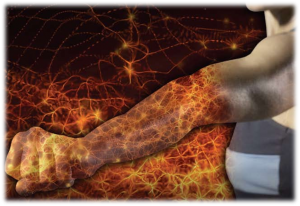My inpatient rehab clinical rotation involved working with patients with amputations and I felt least prepared to work with this population. During this rotation, I worked with knowledgeable therapists and prosthetists, affording me the opportunity to learn from their experiences. With my limited experience working with patients with limb loss, one of the most difficult obstacles to overcome was phantom limb pain. Phantom limb pain is a debilitating factor that has the potential to impede recovery and negatively influence the quality of life. Furthermore, PLP plagues up to 80% of all patients with amputations and it has been difficult to treat clinically. This sparked my interest to learn more about this phenomenon.
My EBP II project focused on analyzing the evidence for interventions for treating phantom limb pain in patients with amputees. More specifically, I chose to research which of the two interventions, mirror box therapy, or immersive virtual reality systems was superior in treating PLP (PICO: In patients with above-the-knee amputations, are virtual reality based interventions superior to mirror box therapy for relieving phantom limb pain?). The information I gathered from my research is that 1) there is limited evidence to support either intervention in the patient population and 2) within the limited evidence that is available; there is inconclusive findings for both. This further validates the difficulty that clinicians often face in their attempts to treat PLP in this population.
My plan for my capstone project was to develop an educational material focused on evidence based treatment options for treating phantom limb pain in patients with lower limb amputation. I have included information about outcome measures to assess pain, treatment strategies, and patient/family education. This material was designed for and will be available to students in the UNC DPT program in the MSK 1 course. I hope that this information will provide students with some knowledge and tools in treating patients with amputations. Although I will not be physically presenting the information, the powerpoint with detailed notes is available for students. For this reason, it was difficult to take into consideration the suggestions for making a great powerpoint and avoiding “death by powerpoint”. My slides have a lot of written information however I try to make sure they are not overwhelming and I chose backgrounds that are not distracting (to improve legibility). Overall, I hope students are able to learn as much as I did about this phenomenon.
My professional plans include working in a rehabilitation setting and my project has helped me to develop evidence-based strategies for working with a population that is commonly seen in this setting. I have learned more about amputations and the evidence based intervention strategies thus preparing me for future clinical practice.
Capstone Materials:
PowerPoint Presentation- Phantom Limb Pain
Evidence table- PLP evidence table
Additional Information about outcome measures- PLP outcome measures
The following are embedded into the PowerPoint via hyperlinks; however, here are copies of the documents:
PLP post test : students will be asked to complete a short post-test to assess what they have learned from the presentation. There is a link to the PLP post test key for students to evaluate their responses. Lastly, there is a final link to the project evaluation where students can provide anonymous feedback on the overall capstone project.Project Evaluation- http://www.surveymonkey.com/s/X9RCD33
Related videos:
Mirror box therapy- [youtube]http://www.youtube.com/watch?v=YL_6OMPywnQ[/youtube]
Virtual reality therapy- [youtube]http://www.youtube.com/watch?v=hlQZmNlPdHQ[/youtube]
Special thanks to my advisor, Jon Hacke, and capstone committee members: Jo Gupta, Heather Fraley, and Dennis Bongiorni.


3 Responses to “Phantom Limb Pain: An Invisible Obstacle to Recovery”
olanike
Thank you ladies!!! I was also surprised that there was not enough research on the effects of exercise. And like you said Aisha, this may be a great follow-up topic; who knows, I just might conduct some of the research myself.
gchristi
Nikki,
This is a very interesting topic! I think that the students will definitely find your presentation to be informative. I really enjoyed the discussion regarding factors that contribute to the development of PLP. Like Aisha, I found it surprising that there was not a lot of research available that examines the effects of exercise on PLP. The videos were great and complimented your project well.
Great Job!
aishaj
Great job on your project Nikki!
Phantom limb pain is a topic that I’m sure that we will become familiar with in our future practice due to the US’s involvement overseas. Your presentation did a great job describing the proposed processes of PLP because I believe it will be critical to recognize the difference “normal” pain and PLP. I am surprised there is not more evidence on the effect exercise has on PLP. That might be a good future follow-up topic.
Aisha